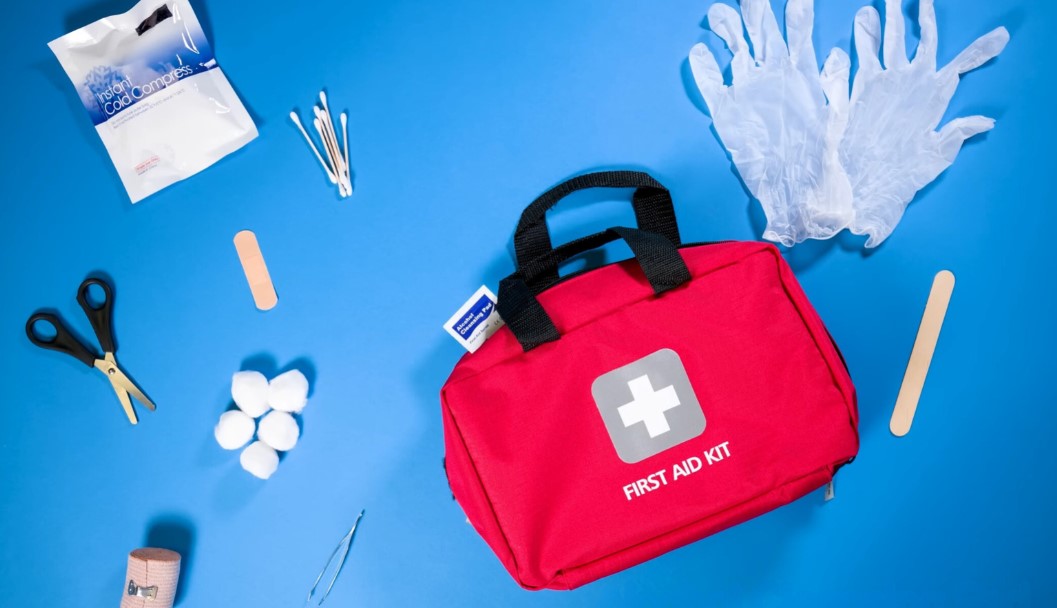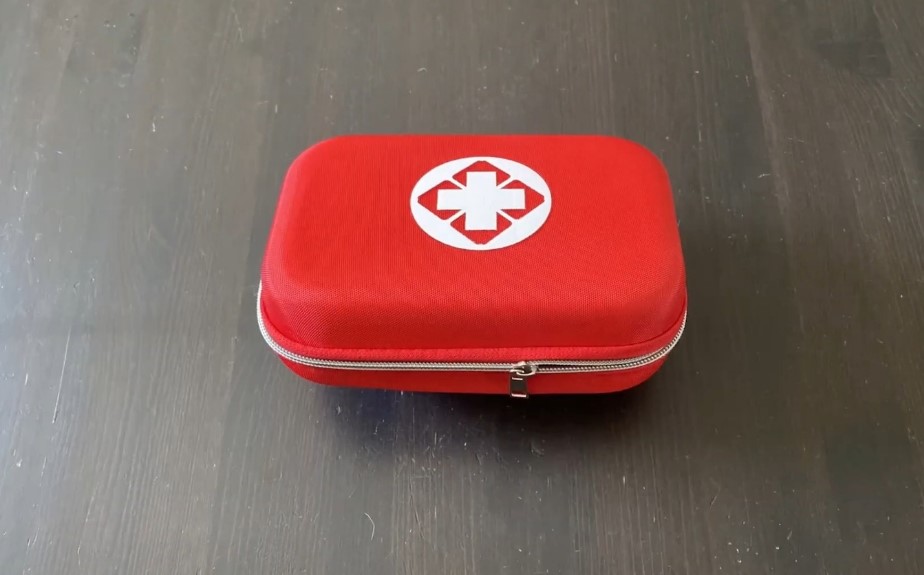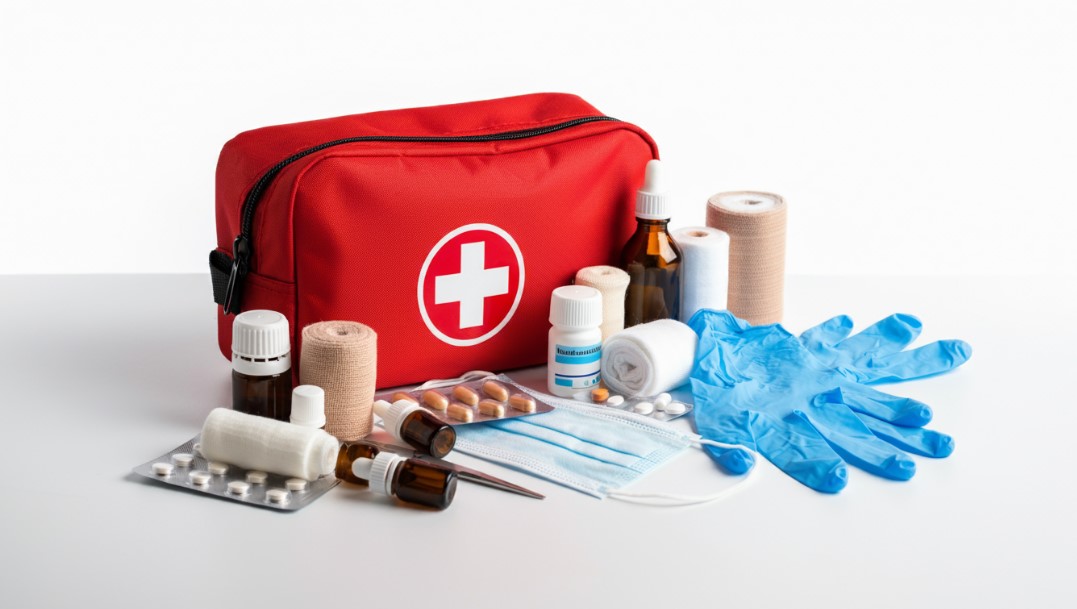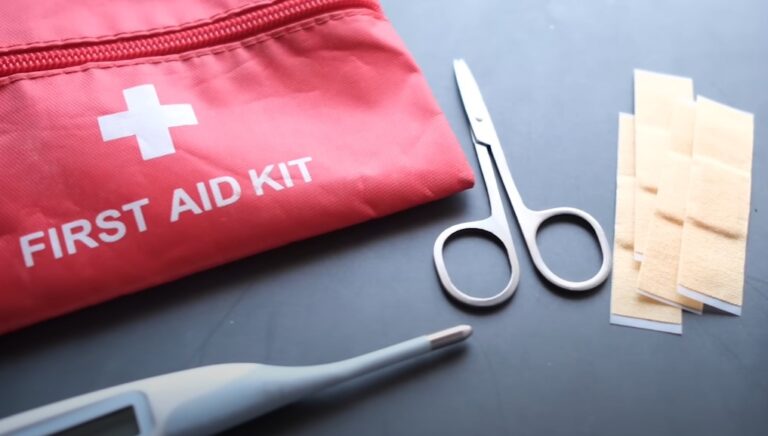In emergencies, on-site treatment saves lives and wins additional time before trained first responders arrive. So keeping a medkit handy and properly stuffed could literally save your or someone else’s life.
Whether you assemble a personal first aid kit item-by-item or opt for a ready-made serial product, check all the details. Today’s article shares how to equip a personal first aid kit. Read on for ways to customize different types of first aid kits for the intended use.
Your Must-Have 20 First Aid Kit Items
Here’s the checklist of 20 essentials you should keep handy in all types of first aid kits.
| Item | Purpose/Use |
|---|---|
| Thermometer | Use a digital thermometer for accurate temperature readings. |
| Disinfectant Wipes | Clean wounds; avoid alcohol-based solutions for open wounds. |
| Scissors | Cut gauze and tape rolls easily. |
| Sterile Gauze Pads | Cover and compress heavily bleeding wounds. |
| Tweezers | Remove splinters or bee stings. |
| Basic Bandages | Roll bandages for general external injuries. |
| Triangular Bandages | Use as an arm sling for fractures or swelling. |
| Liquid Bandage | Seal small cuts with antiseptic adhesive. |
| Self-Adherent Wraps | Elastic wraps to compress injuries and secure dressings. |
| Burn Dressings | Apply to burns for pain relief and cooling. |
| Surgical Tape | Secure gauze or layered dressings. |
| Splints | Support fractures with wooden, wire, or finger splints. |
| Emergency Blanket | Provide warmth for cold or wet individuals. |
| Ice & Hot Packs | Apply for cooling or warming injuries. |
| Sterile Eye Dressing | Protect and treat eye injuries. |
| Safety Pins | Secure bandages tightly. |
| Antihistamine Cream | Soothe skin allergic reactions. |
| Painkillers | Relieve pain with ibuprofen, naproxen, or aspirin. |
| Sterile Gloves | Ensure sanitation when treating open wounds or burns. |
| First Aid Manual | Guide for performing first aid procedures correctly. |
Why Having a First Aid Kit is Essential

You can always find something in a personal first aid kit to ease the symptoms, whether it is nausea, fever, headache, or sprained and swollen limb. Getting or providing immediate first aid helps in three ways:
- You can continue with your current business. When the ailment strikes, you can cope with it or get help from bystanders. No need to waste time traveling to urgent care or emergency care rooms.
- You prevent health deterioration. Even a slight scratch might get infected if overlooked. So the faster you get or provide comprehensive on-site treatment, the smoother and quicker further recovery will be.
- You eliminate imminent life risks. Acute illnesses and major traumas pose an actual death risk. Surviving chances get even thinner in case of occupational accidents at a dangerous workplace. But with the well-stocked first aid kit, personnel can effectively combat life-threatening injuries.
Although, you must realize that relying on a set of some 20 first aid kit items isn’t a magic bullet. Perhaps, you already followed American National Standards Institute (ANSI) recommendations and stoked personal first aid kit accordingly. But still, it won’t hurt to double-check your domestic and work environments to see if it’s enough. Especially if you’re responsible for the well-being of your household, serve as a caregiver, or have dependents.
Keeping in Mind Home Hazards
Perhaps, you’ve followed our tips on mitigating home safety hazards and made your place cozier and safer for the entire family. But take some time to rethink if anything has changed in your life. It could be:
- getting a pet
- starting regular home workouts
- starting a renovation.
Even such casual things require an additional safety check (i.e., you’ll need to stock up on allergy meds in case one of your guests is allergic to pets). So consider some possible emergency scenarios from various angles to decide what types of first aid kit to purchase.
Ensuring safe travel & outdoor vacation
Outdoor health emergencies might be nothing like domestic ones. We bet you don’t keep a snake venom extractor or foil blankets in your home personal medical kit. But these are common for people who are into hiking. So don’t forget to include activity-specific items to your personal first aid kit time to get forearmed.
Stock ANSI-Compliant Med Kits for the Workplace

Types of first aid kits differ industry-to-industry. For instance, OSHA designates a list of mandatory medical equipment for the logging industry. Those are mostly bandaging materials (gauze pads, adhesive bandages, tapes, splinting tools) and similar first aid kit items for typical injuries.
Contents of workplace first aid kits must also comply with ANSI/ISEA Z308.1-2021 national standard. It defines minimum performance specifications set by the International Safety Equipment Association (ISEA) and ANSI. Regarding the complexity of the work environment and overall level of hazards, ANSI/ISEA specifies A and B classes of first aid kits.
- Class A – a starter-level kit designed for common workplace injuries (cuts, abrasions, minor burns, and eye injuries).
- Class B – intended for broader application as it helps treat personnel at more populated facilities with more risky environments. Unlike class A kit, this one must contain a splint and tourniquet.
If you take charge of workplace safety and first-aid arrangements, please, pay attention to the classification of med kit containers. Some kits are designed for fixed wall mounting, whereas others are sealed in portable cases to withstand rough handling. Consider this to decide which types of first aid kit suit your work environment most.
Types of First Aid Kits that Match the Case

Try customizing an already available set of medical supplies to cope with health emergencies most efficiently. Alternatively, you can buy the stocked personal first aid kit for yourself or your loved ones.
Based on the possible intended use of med kits, we listed some case-specific meds for individual needs not covered by the basic 20 first aid kit items.
First Aid Kit Items for Seniors’ Use
Сardiac arrests and strokes account for the most severe conditions affecting seniors. Id you ever need to deal with those, it’s vital to carry out on-site CPR to restore breathing and blood circulation as quickly as possible.
Add a CPR mask, aka breath barrier, to the personal first aid kit you keep at your place or elderly relative’s house. It’s not as difficult to use as it appears but rather beneficial regarding up-to-date COVID-19 concerns. The mask with a one-way valve will protect you from getting infected.
First Aid Kit Items for Families with Kids
View this post on Instagram
Parents are accustomed to the role of kids’ first aiders as they always cope with minor bruises, abrasions, and burns. Most types of first aid kits have bandages, antiseptics, and cooling sprays you can instantly use when children get hurt.
Therefore, we’d rather recommend you equip additional medical products if you plan to go somewhere far. Such might be cases like camping or family relocation. Pack extra meds that can relieve flu or heat exhaustion symptoms, treat food poisoning symptoms, etc.
Optionally, you can add the following helpful items:
- Extra flashlight
- Antihistamine drugs for allergies
- Sorbent pills
- Over-the-counter analgesics/painkillers
First Aid Kit Items for Caregivers
Home health nursing requires a tailored approach. Suppose you look after a bedridden patient or a wheelchaired person. In such cases, bedsore prevention and skin hygiene play a significant role in daily care. So stock the following items:
- Moistened and dry towels
- Аntibacterial wipes
- pH-balanced skin care lotions
- Several changes of clean clothing
- Incontinence products.
If nursing implies supervision and treatment of patients with obstructed breathing, most likely, you’ll need respiratory tubing and prescribed inhalers in addition to your basic list of 20 first aid kit items.
First Aid Kit Items for Chronically Ill People
Heart diseases, cancer, diabetes, asthma, Alzheimer’s, and chronic lung and kidney diseases are all serious conditions. These insidious ailments exacerbate without regular screening and following prescription medication strictly. So primarily, we suggest you consult with the treating MD on what meds to include in your personal first aid kit to suppress a sudden health condition aggravation.
That said, you can add a couple of over-the-counter (OTC) products to the default 20 first aid kit items:
- Primatene Mist HFA and Asthmanefrin can help with mild intermittent asthma.
- Aspirin will ease chest pains and is a must-have medkit item for those recovering after a heart attack.
- Ibuprofen relieves arthritis pains.
NOTE:
- Chronically ill people are generally more susceptible to infections. So sanitize your hands or put on sterile gloves from a personal first aid kit before touching their eyes, mouth, or open wounds.
- Stock additional prescription meds to all medkits a person usually uses. Store this stash of drugs in personal first aid kits at home, office, and car.
- Besides emergency medications that suppress acute symptoms, caregivers and patients can benefit from personal well-being trackers. Those might be personal safety apps, wearable alarm devices, or in-home medical alert solutions.

